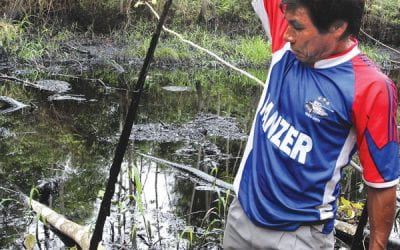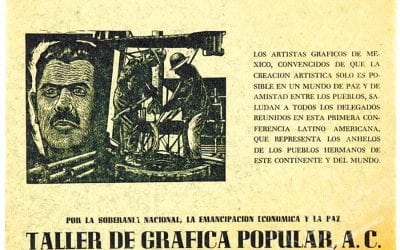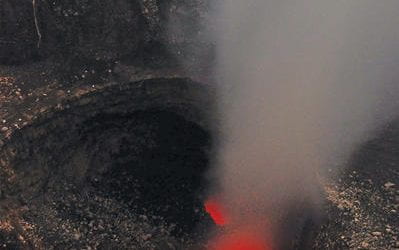Forests for Energy?
Biofuels and Palm Oil in the Peruvian Amazon

Settlers near caserío Nueva Italia, San Martín region, Peru, located on the edge of Palmas del Shanusi plantation. Photo by Thomas Müller/Peruvian Society for Environmental Law (SPDA).
In 2008, I was conducting fieldwork on the edges of a recently established large-scale oil palm plantation: Palmas del Shanusi. My investigations took me to the caserío of Nueva Italia, in the area known as Cainarachi, between the San Martin and Loreto regions in the Peruvian Amazon. A conflict had been triggered there between the company, part of the powerful Grupo Romero, and people from the plantation surroundings. To get there, two colleagues and I drove along one of many timber roads that penetrate into the forest from the recently built North Interoceanic Highway.
The landscape of destruction was impressive. On each side of the road we saw recent or ongoing clear-cutting of the forests. New migrants had a deal with madereros (timber merchants) operating in the area: they wanted the madererosto extend the road to make their farms more accessible so they paid them with timber from trees they cut down. At the end of the road, a trail started (where the road is presumed to continue as clearing advances). After walking for 15 minutes, we arrived in Nueva Italia, where we found a few ramshackle huts and scarce fields for crops. Most of the settlers had recently migrated from the Andes, they told us, although they mentioned other residents who had been in the area for decades.
The settlers explained they were resisting the company’s unstoppable clear-cutting of forests and took us to the very edges of the company’s operations. We walked along a trail under a canopy that suddenly stopped by a fallen log, opening the view to thousands of acres of clear-cut past forests. The expansion of the agricultural frontier on the forests revealed a whole new, massive and industrial dimension. Security guards approached us, and before asking us to leave, explained that they had all legal permits to operate in that land.

Deforestation for oil palm in Loreto, Peru. Photo by Thomas Müller/Peruvian Society for Environmental Law (SPDA).
Local conflict and large-scale deforestation are the most visible dark sides of oil palm plantations. The oil extracted from the fruit of the plant (palm oil) is used for vegetable oils and fats (used for chips, chocolate and cooking oil, for example), cosmetics (soap, shampoo, body creams, etc.) and, more recently, biodiesel. The new and growing market for biodiesel from palm oil and its accompanying narrative of green energy captured my interest and had brought me to the plantations in the first place. Peru had recently passed biofuels regulations, and oil palm plantations were rapidly expanding in the Amazon. Facing the landscape of destruction, it was hard for me to remain enthusiastic about the environmental credentials of biofuels.
The Law of Promotion of the Biofuels Market (2005) stated that energetic crops are an opportunity for agro-industrial development, a source of jobs and an alternative to illegal crops (coca). Peru introduced a progressive blending schedule of biofuels beginning in 2009, though implementation was delayed several times due to technical problems with refineries and gas stations. Today there is a mandatory blend of 7.8% ethanol in gasoline and 5% biodiesel in diesel. To fulfill the demand generated by this law, an estimate of 250,000 tons is required annually, i.e. approximately 173,000 additional acres (depending on productivity per acre).
Palm oil is one of biodiesel’s most important components. The crop has steadily expanded globally in the past three decades, given its large yields (it is the most efficient oleaginous crop in the world), its high value compared to other agricultural products, and rising demands for its many uses. Southeast Asia has been the predominant producer region since the 1980s, processing around 90% of the world’s palm oil. Partially because available land in that region is diminishing, the industry is also growing in other tropical areas such as Africa and Latin America. Much of the Amazon rainforest is suitable for oil palm cultivation. In the case of the Peruvian Amazon, in addition to biophysical suitability, the recently pacified region has a growing transport infrastructure and a favorable legal framework for the establishment of oil palm plantations, which are rapidly expanding.
The passing of biofuel regulations has spawned the development of many new biofuel projects. Biodiesel mills in Lima, sugar cane plantations and ethanol mills on the northern coast and new oil palm plantations and biodiesel mills in the Amazon are some examples. The most visible investment was made by Grupo Romero, which in addition to the new Palmas del Shanusi plantation, built a biodiesel mill in its long-established Palmawasi plantation in Tocache.
The biodiesel business turned out to be a major failure for domestic producers, unlike ethanol which, though with some difficulties, has been profitable for sugar cane investors on the coast. Both small and large-scale oil palm growers saw a secure market for biodiesel production, and invested accordingly. But refineries, both public and private, preferred to buy imported biodiesel. They claimed that Peruvian palm oil biodiesel didn’t meet the technical specifications required by law. Allegedly, Amazonian biodiesel didn’t respond well to cold temperatures when transported across the Andes. Biofuel producers have been working to meet the technical criteria, though they claim that the criticisms are unfounded. The real reason is that refineries prefer to buy subsidized and dumping-priced (i.e. cheaper) imported biodiesel, most of it coming from Argentina, they contend. The impasse has been taken to INDECOPI (the regulatory organization for competition in Peru), which in 2010 applied compensatory measures in favor of domestic production, but only for a limited period of time. Industrias del Espino, part of Grupo Romero, formally denounced unfair competition from Argentine biodiesel, and the case is under a new investigation by INDECOPI.
In April 2014, Grupo Romero announced the closing of its biodiesel mill, after almost five years of operation at less than 20% of its capacity. Peasants with small plots of land have also denounced the biofuel policy as a false promise. Many point out that farmers had substituted oil palm for coca because of that promise, and now find themselves without markets to sell their products.
The 2005 biofuels law aimed to diversify Peru’s energetic matrix and agroindustrial development, and stimulate the conversion of illegal crops through state promotion on the basis of free competition. Under a free-market economy like Peru’s, there was no guarantee that the demand could be met with domestic production. Unlike the situations in Ecuador, Colombia or Brazil, where biofuels producers coordinate with their national states to secure domestic consumption of domestic production, this has not been the case of Peru, where improvisation and lack of planning are the rule rather than the exception. Dumping practices are incompatible with free competition, and INDECOPI might rule in favor of domestic oil palm producers in future months. But it is quite ironic that producers call for state intervention when it comes to commercial matters, and show no enthusiasm at all when it comes to environmental and zoning regulations for oil palm projects.
Oil palm expansion has far from stopped, however. On the contrary, the crop is growing at a higher pace than ever. Cultivated surface area of the crop has grown from 35,000 acres in 2000 to around 150,000 acres in 2013. About two-thirds (around 100,000 acres) have been cultivated by peasant associations of small landholders, in most cases with support from international cooperation, as an alternative to coca growth. But this ratio is changing, as currently another additional estimated 280,000 acres in large-scale projects are pending approval or starting operations. Two large-scale companies are leading the expansion. One is the pioneer Grupo Romero. The other is the recently arrived holding company created by investor Dennis Melka, a Czech citizen, and his associates, locally known as los malayos (the Malaysians) after the established oil palm plantations they own in Malaysia.
These new plantations have been involved in large-scale deforestation. In most cases, companies are attempting to buy large, contiguous forested lands from the state, free from legal claims by settlers or communities. Selected areas require the appropriate biophysical conditions (in terms of soil quality, temperature, slopes, etc.) for oil palm to grow. Deforested lands do not always meet these conditions, and their soils are usually degraded. Buying forested land can be very cheap because of good prices from the state. The resulting timber can be sold or used for building camps; the deforested, non-commercial biomass is left to rot to fertilize the soil.
The Peruvian Ministry of Agriculture and oil palm producers claim that oil palm projects don’t involve deforestation. When evidence against this is shown, they explain that the projects are developing in soil categorized as suitable for agriculture; so legally speaking, they are not cases of deforestation. The Roundtable on Sustainable Palm Oil (RSPO) recently started its implementation in Peru and is currently working on a “National Interpretation Draft of RSPO Principles and Criteria.” One of the criteria for certification is precisely that plantations don’t involve deforestation. It is yet to be seen how certification is going to address the cases of so-called legal deforestation.
Forestry regulations are contradictory in Peru, and the institutional framework is going through critical changes, which makes the procedure for starting oil palm projects particularly unclear. Through decentralized regional governments and the participation of the Ministry of Agriculture, the state has been active in promoting projects and has issued some legally questionable permits; however, the Ministry of Environment has taken legal action to stop deforestation brought about by the spread of the crop.
Despite the failure of the nationally produced biodiesel business in the past decade, oil palm cultivation is growing in the Peruvian Amazon. There is an expectation that, in the future, after technical and competition barriers are overcome, biodiesel will still be an important market for Peruvian palm oil, especially when it is portrayed as a green alternative to fossil fuel dependency.
Of course, not all agriculture-based biofuels production necessarily entails large-scale deforestation and social conflict. Crops can be grown in different areas, under various production techniques and social arrangements, such as, for example, associations of peasant landowners who abandon coca growth for a legal activity such as palm oil production in already degraded areas. Making these distinctions is crucial, but what we might call sustainable biofuels are unlikely to be developed under weak institutional and contradictory legal frameworks such as those of Peru. Furthermore, narratives of green energy and sustainable production are heard too often but seldom seen on the ground.
Demand for biofuels is growing globally, and it also comes from areas that are not important biofuel producers such as the European Union (EU). Organizations like Oxfam and Friends of the Earth are highly critical of the EU’s biofuels target, as these organizations claim that the EU doesn’t take into account the impacts of biofuel production on people and the environment in producer countries.
According to Oxfam (2012), biofuels are an important driver of the global rush for land deals, or land grabs, and countries with poor protection of land rights (like Peru) are magnets for land deals involving biofuels, or crops that can potentially be used for biofuels production (like oil palm). This is what we witnessed in Nueva Italia: capitalist companies partner with fractions of the state to purchase large tracts of land, and poor farmers migrate to the area to secure land that is perceived to be scarce, reinforcing conflicts over land and patterns of forest destruction.
Using vast areas of land for biofuels production reduces the amount of land that can potentially be used for food production. And as we have seen, it may involve large-scale deforestation. This leads us to the obvious question of how convenient is it for a country like Peru, with the second largest forest cover in Latin America, to destroy its forests to produce fuels. Biofuels projects gained momentum as a clean fix to the energy crisis of fossil fuels, regarded as polluting and perceived as scarce. However, a massive transition to biofuels could bring about unforeseen impacts such as land grabs, diminishing available land for food and large-scale deforestation. All for the quest to maintain or increase the current high energy consumption rates, which always seems to be the indisputable priority.
Fall 2015, Volume XV, Number 1
Juan Luis Dammert B. is a Ph.D. Candidate in the Graduate School of Geography, Clark University. jdammert@clarku.edu
Related Articles
Oil and Indigenous Communities
On a drizzly morning in late February, a boat full of silent Kukama men motored slowly into the flooded forest off the Marañón River in northern Peru. Cutting the…
Mexico’s Energy Reform
The small, white-washed classroom at the University in Minatitlán, Veracruz, was packed with a couple dozen people who, although neighbors, had never met…
Geothermal Energy in Central America
When we think about global technology leaders, Central America does not typically come to mind. But Central American countries have indeed been in the…




